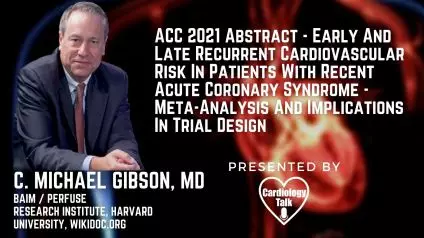C. Michael Gibson, MD @CMichaelGibson @BaimInstitute @harvardmed #ACC21 #AcuteCoronarySyndrome #Cardiology #Research ...
C. Michael Gibson, MD, CEO non-profit Baim / PERFUSE Research Institute, Harvard Professor, Cardiologist BIDMC, Founder & Chairman WikiDoc.org speaks about ACC 2021 Abstract - Early And Late Recurrent Cardiovascular Risk In Patients With Recent Acute Coronary Syndrome - Meta-Analysis And Implications In Trial Design
Link to Article:
abstractsonline.com/pp8/#!/9228/presentation/22780
Summary -
Background information:
Despite receiving excellent medical treatment, people with an acute coronary syndrome have a significant residual atherosclerotic risk (ACS). The goal of this research was to calculate the risk of early and late major adverse cardiovascular events (MACE) and consider the implications for trial design.
Methodologies: To find phase III interventional studies on high-risk ACS patients, a thorough search was conducted. Meta-analytic techniques were used to estimate pooled incident rates at 90 and 360 days by fitting a random-effects model using the DerSimonian-Laird technique. The connection between power and relative risk reduction (RRR) or absolute risk reduction (ARR) for early vs. late MACE endpoints was investigated using the log-rank test (n=10,000; 1-sided=0.025).
The following are the outcomes:
A total of 82,727 high-risk individuals with recent ACS were examined from seven studies. After 90 days, the pooled rate of recurrent MACE was 4.1 percent (95 percent CI: 3.0 percent-5.7 percent), and at 360 days, the rate was 8.3 percent (95 percent CI: 7.1 percent -9.8 percent). Within the first 90 days, approximately 49% of incidents happened. For late MACE, a lower RRR (22 percent vs. 30 percent) is required to achieve 90 percent statistical power, but for early MACE, a lower ARR is required (1.2 percent vs. 1.8 percent ).
Final Thoughts:
The first 90 days after an ACS occurrence are most sensitive to recurrent MACE. Determining a clinically meaningful benefit by relative vs. absolute risk reduction may impact the choice of early vs. late MACE as the research endpoint from a trial design standpoint.




